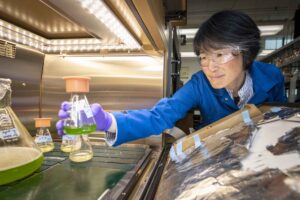
One of the five strategic research themes at the Lab, selected for their potential to unlock the greatest scientific opportunities over the next decade, focuses on “discovering materials, chemical processes, and biological systems for energy and the environment.”
Setsuko Wakao’s team in the Biosciences Area’s Molecular Biophysics and Integrated Bioimaging (MBIB) Division, working with scientists in the Energy Sciences Area’s Molecular Foundry and Materials Sciences Division, is conducting research that could do just that. The team is working to deliver a deeper understanding of a group of algae, called diatoms, and potential applications. She spoke with Research News about her work.
How did you get into this area of research?
I’m a biologist, and I have been working on the genetics of photosynthesis for many years, in particular, on algal systems. A group of algae called diatoms makes biominerals – hard materials of silica – created from soft organisms. Diatoms are important to the carbon cycle, taking up 20% of the planet’s carbon dioxide through photosynthesis. But they could potentially have other uses as well. Imagine that instead of making plastic or styrofoam from fossil fuels, you could make them from biomaterials that are not harmful to the environment. Diatoms can make such hard materials with resources that are plentiful: silicon, the second most abundant mineral on earth and which dominates the oceanic environment. And they don’t require high temperatures or a lot of energy to create these materials.
My team is working to understand how diatoms make these materials and whether they could be engineered for other purposes. The material is hard yet porous, so some of the possible applications to explore are the filtration of toxic metals at contamination sites or the recycling of rare metals from batteries. Because of the material’s nanoscale properties, other potential applications are as photonic materials, which can emit, detect, or manipulate light, or as drug delivery materials that release chemicals slowly.
The research is very much interdisciplinary. Biologists are good at studying bioprocesses. But biomineralization has to do with, not enzymatic reactions, but chemical and physical reactions – how elements concentrate, precipitate, and how crystals grow into other structures. So I work with chemists, materials scientists, and physicists, who explore how to treat or coat the cell structures with other molecules so the cells can be used for different applications.
What has the experience of interdisciplinary research been like?
Multidisciplinary science is easy to talk about but hard to do. Scientists who work with nanomaterials may not be used to working with biological materials, and biologists are not used to treating cells as something inorganic. If I am preparing cells for a chemist or a physicist, I can’t just hand them over an untreated culture. The cells could be too small or too big, or the structures too thin for experiments or examination, and other times they need to be pre-treated to be applicable to their methods. Other challenges include the ability to quantify cell traits or the yield of a chemical reaction using cells. I think a lot of multidisciplinary research could fail there – the challenge of putting numbers on biological processes that are inherently variable.
We spend a lot of time understanding the limitations of different techniques, and how to expand these techniques or explore new techniques for our multidisciplinary research. It takes persistence to make multidisciplinary research work.
Our Laboratory Directed Research and Development funding from FY2023 helped us initiate the work. Now, we have a better understanding of the technical hurdles and can design proof-of-concept experiments, such as enzymatic reactions that enable binding metals onto a diatom cell surface.
What are the next steps for your work?
Once we can successfully carry out proof of concept reactions, we can take the next steps, such as exploring whether we can bind only specific metals with high affinity. This could help in the recycling of rare metals that might be useful in the energy revolution. Or it could remove pollutants such as forever chemicals, which is something we currently do not have a means of doing. There are many potential directions for this research: in nanotech, biotech, and biomedicine, for example.
The beauty of this method is that using cells as starting materials and enzymatic reactions that require mild conditions are more ecological than harsh chemical treatments or reactions that need energy input like heat. Diatoms can unlock new paths to sustainability while also contributing to CO2 reduction through photosynthesis. They represent a potentially multi-path strategy towards sustainability.
For more information:
https://newscenter.lbl.gov/2024/01/16/basics2breakthroughs-harnessing-the-superpowers-of-diatoms/

